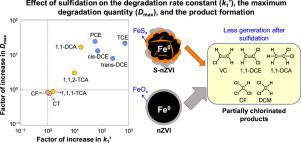Water Research ( IF 11.4 ) Pub Date : 2021-06-04 , DOI: 10.1016/j.watres.2021.117328 Yanyan Zhang 1 , Pinar Ozcer 2 , Subhasis Ghoshal 2

|
Sulfidated nanoscale zerovalent iron (S-nZVI) is a promising reductant for trichloroethylene in groundwater, yet a comprehensive understanding of its degradation efficiency for other chlorinated hydrocarbons (CHCs) is lacking. In this study, we assessed the benefits of using S-nZVI for the degradation of two chlorinated methanes, three chlorinated ethanes, and four chlorinated ethenes compared to unamended nZVI, by analyzing the degradation rate constants, the maximum degradation quantity, and the degradation pathways and products under both stoichiometrically electron excess and limited conditions. The improvement in rate constants induced by sulfidation was compound specific and was more significant for chlorinated ethenes (57–707 folds) than for the other CHCs (1.0–17 folds). This is likely because of the different reduction mechanisms of each CHC and sulfidation may favor specific mechanisms associated with the reduction of chlorinated ethenes more than the others. Sulfidation of nZVI enabled either higher (3.1–24.4 folds) or comparable (0.78–0.91) maximum degradation quantity, assessed under electron limited conditions, for all the CHCs investigated, indicating the promise of S-nZVI for remediation of groundwater contaminated by CHC mixtures. Furthermore, we proposed the degradation pathways of various CHCs based on the observed degradation intermediates and products and found that sulfidation suppressed the generation of partially dechlorinated products, particularly for chlorinated methanes and ethanes, and favor degradation pathways leading to the non-chlorinated benign products. This is the first comprehensive study on the efficacy of sulfidation in improving the degradation of a suite of CHCs and the results provide valuable insight to the assessment of applicability and benefits of S-nZVI for CHC remediation.
中文翻译:

硫化纳米零价铁对C1和C2氯化烃降解的综合评价
硫化纳米级零价铁 (S-nZVI) 是一种很有前景的地下水中三氯乙烯的还原剂,但对其对其他氯化烃 (CHC) 的降解效率缺乏全面了解。在本研究中,我们通过分析降解速率常数、最大降解量和降解途径,评估了使用 S-nZVI 降解两种氯化甲烷、三种氯化乙烷和四种氯化乙烯与未改性的 nZVI 相比的优势以及在化学计量电子过量和有限条件下的产物。硫化引起的速率常数的改善是化合物特异性的,对于氯化乙烯(57-707 倍)比对其他 CHC(1.0-17 倍)更显着。这可能是因为每种 CHC 的还原机制不同,硫化可能比其他机制更倾向于与氯化乙烯的还原相关的特定机制。在电子限制条件下,对所有调查的 CHC 进行 nZVI 硫化,可以实现更高(3.1-24.4 倍)或相当(0.78-0.91)的最大降解量,表明 S-nZVI 有望修复受 CHC 混合物污染的地下水. 此外,我们根据观察到的降解中间体和产物提出了各种 CHC 的降解途径,发现硫化抑制了部分脱氯产物的产生,特别是对于氯化甲烷和乙烷,并有利于导致非氯化良性产物的降解途径。











































 京公网安备 11010802027423号
京公网安备 11010802027423号